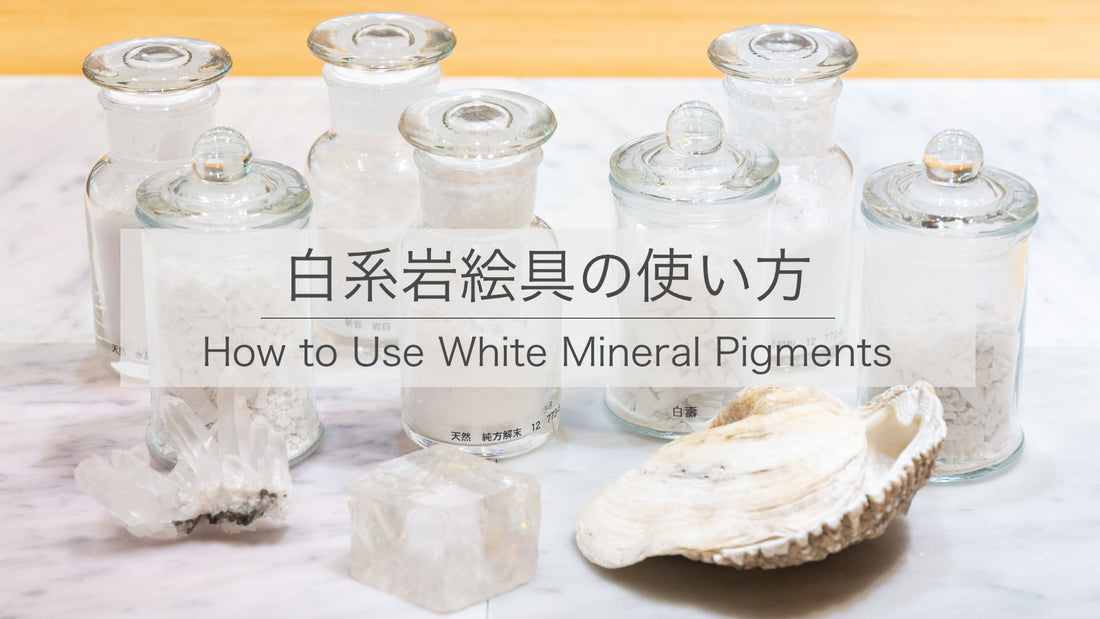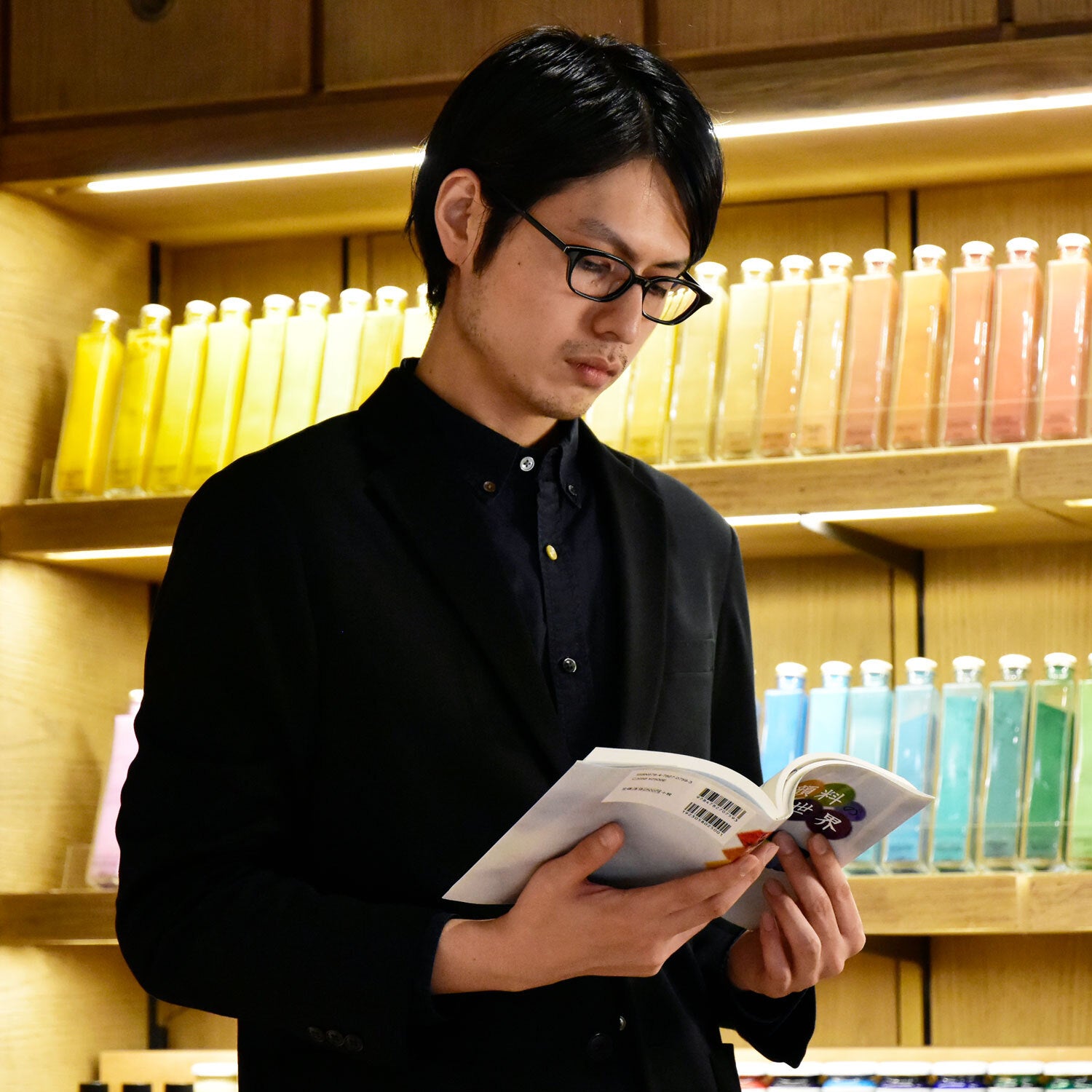Just as there are silver white and titanium white in oil and acrylic paints, there are different kinds of whites in mineral pigments for Japanese painting too.
However, unlike other pigments, mineral pigments cannot be mixed to create colors because of their heavy specific gravity.
Therefore, white mineral pigments are often used with animal glue to glaze painting surfaces or simply as a base color rather than mixing with other pigments to increase the brightness of the paints.
Of course, it is possible to mix mineral pigments, but each pigment should have the same specific gravity to do so.
Without further ado, let's take a look at the characteristics of these white mineral pigments.
Natural Suishomatsu is a white mineral pigment made from ground crystal quartz.
Its translucence characteristic can give a shimmering white tint to a painting by applying a thin layer over a coat of mineral pigments or Suihi pigments (tinted pigments). Natural Suishomatsu is the lightest white among the white mineral pigments introduced here.
You can create a rough textured painting surface with the grains of quartz which is different from the texture of mica (also known as Kira).
Natural Junhokaimatsu is a translucent mineral pigment made from ground calcite.
It has more hiding power than Suishomatsu and is slightly translucent white.
Natural Junhoukaimatsu is also used to create textures by piling up the painting surface.
The raw mineral of this color is very brittle and will break into plate-like shapes when it's crushed, which is useful when you want to scrape it with a painting knife or other tool.
Iwagofun is made by grinding marble stones.
It has the highest hiding power and is the most opaque among the white mineral pigments listed here, therefore, it is best for using as undercoating and creating textures like gofun.
And of course, the warm touch of texture unique to natural minerals is one of the main characteristics of this pigment too.
Although Natural Suishomatsu, Natural Junhokaimatsu, and Natural Iwagofun are mineral pigments made by pulverizing natural minerals, Shin-iwa Iwa Shiro is made by crushing a block of lead glass mixed with pigment. The pigments made by this method are called Shin-iwa pigments or artificial mineral pigments.
The common characteristics of Shin-iwa pigments are modern color tones, moderate hiding power, and a slightly matte finish when applied to the surface compared to natural mineral pigments.
And for the Shin-iwa Iwa Shiro, it has a yellowish tint compared to the above whites.
Gofun is a calcium carbonate-based pigment made from natural Itabo oyster shells (the type of shell used varies by manufacturers). Although technically Gofun isn’t mineral pigment, it is one of the essential colors in Japanese painting.
Before pulverizing shells, they have been exposed to the outdoors for more than 30 years, and then crushed in a millstone, later refined again in water several times, and lastly, dried these crushed powders into thin plate forms naturally.
It is used not only as a white paint but also as modeling paste; or by adding dyes to use it as a pigment, for example, Gofun is also the raw material for making Suihi pigments.
In PIGMENT TOKYO, we offer different grades of Gofun, from Miyako-no-Yuki, which is kneaded with animal glue and comes in tubes, to Shirayuki, Hakujuin, and Kinhoin.
The difference between the grades is part of the shell used, which gives them a different whiteness.
A thick large top valve is used to produce Kinhoin which has the most beautiful white and is ideal for the finish layer of paint. Hakujuin is made from a smaller valve than the one used for Kinhoin; Shirayuki is a combination of top and bottom valves, which are suitable as a primer for painting.
You may refer to the following color sample to see the result of these white pigments painted on a dark background.
For the base color, I painted purple acrylic paint on watercolor paper made of bamboo fiber, and each white is tested on top of it using gum arabic as the binder.
You can see how each color appears on top of the base color.

【Art Materials Used】
Substrate: Bamboo Washi for Watercolor Art Pad
Base Coat: Acrylic Paint
Binder: Gum Arabic
Colors: Natural Suishomatsu, Natural Junhokaimatsu, Natural Iwagofun, and Shin-iwa Iwa Shiro
【Art Materials Used】
Substrate: Bamboo Washi for Watercolor Art Pad
Base Coat: Acrylic Paint
Binder: Gum Arabic
Colors: Gofun Kinhoin, Gofun Hakujuin
Therefore, even though it seems the white mineral pigments resemble each other, there are various ways to use them, depending on their characteristics. Some artists mix white mineral pigments to create their own modeling paste and the ways of using the white mineral pigments in this article are just a few examples, so I encourage you to find the best way to use them for your artwork.
Also, you can find a comparison of white pigments in the article below.
Which White Should I Use?
Translated by Atsumi Okano and Nelson Hor Ee Herng
PIGMENT TOKYO Art Materials Experts







